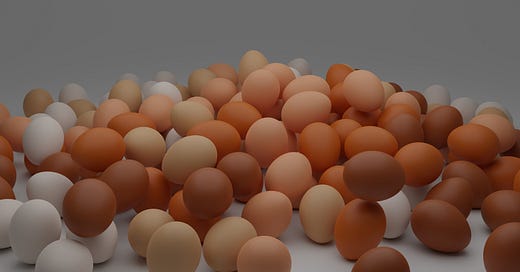🍦 Don't Be Fooled by the Commonness Fallacy
Why vanilla is a less popular choice than you think
In science, we constantly look for new and interesting examples of cause and effect. But like everyone in the world, scientists get tempted by simple, easy-to-sell stories for explaining complicated events. This can lead to groundless attributions of causality. For example, here’s an overoptimistic Harvard Medical School article that uses correlational data to claim “people who take frequent saunas or hot baths may lower their risk of heart problems”.
One reason people misattribute cause and effect is because of “confounding variables”. If variable B increases as variable A increases, the most attractive conclusion is “wow, A causes B”. But it’s possible that you’re missing a separate, hidden variable C—a confounding variable—that causes both of them to increase. Variable C might cause A to covary with B even when there’s no real direct connection between A and B.
I recently misattributed cause and effect when I was out with a friend at a bar. After a couple of rounds of beer orders from me and cocktail orders from him, I naturally assumed he preferred the taste of cocktails to beers, since most people order what they enjoy drinking. But later in the night, I learned he was allergic to hops. My assumption that people always order what they like to drink was wrong. I could have avoided this error if I had tested my friend’s immune system with a blood sample before hanging out with him, but this isn’t something I typically do.
There are all kinds of hidden variables impacting the events in our lives completely outside our knowledge, fooling us into seeing causation where there is none. These errors affect our daily decision-making and may underlie a behavioral bias that researchers are calling the “commonness fallacy”. It turns out that we’re often wrong about people’s everyday choices—including which drink they’ll order—because we confuse ubiquity for preference.

🪤 Uncovering the commonness fallacy
In a 2020 research paper, researchers in California ran several studies to uncover what they called the “commonness fallacy”. In their first experiment, they showed 110 people 11 pairs of items and asked them to pick their preferred option in each pair. They also asked each person to predict how often other people would choose each item.
Items could fall into a range of categories including food, flowers, and drinks, but every pair of items featured one highly common option and one rarer option. For example, when choosing between drinks, people could select an orange juice (common) or a passion fruit juice (less common). When choosing between desserts, people could select vanilla ice cream (common) or tiramisu (less common).
People’s personal preferences showed an even split between the items: they chose the common option 50% of the time and the uncommon option the other 50% of the time. This isn’t how they expected other people to generally behave though; they expected people to choose the common option 59% of the time.
To make the question less hypothetical, the researchers ran another version of the experiment with 199 people. Instead of asking “what would you choose if you could?”, they placed two chocolate bars in front of people and asked them to take their preferred option. One was a commonly available Original Milky Way and the other was a less common Midnight Dark Milky Way. They also disguised everyone’s choices so that participants knew their selections were private, just in case anyone was worried about looking socially odd.
Consistent with the previous results, 55% of people chose the more common chocolate bar but predictions were higher at 63%. This inflated belief was associated with the degree of commonness people linked to an Original Milky Way: the more frequently they came across it in life, the more they expected it to be chosen in the experiment.
In another study with 113 participants, the researchers tested whether manipulating a person’s perception of commonness would directly affect their beliefs. They showed each participant a series of choices made by a fictional character named John who walked into various stores and chose between available candy bars. Across 96 binary choices John made between chocolate bars, a highly common chocolate bar was available in every choice. The alternative choice featured either a moderately common chocolate bar which appeared in 64 choice pairs or an uncommon chocolate bar which appeared in only 32 choice pairs.
In each trial, John chose between the two available chocolate bars at random. He displayed no preference whatsoever for a particular option. But the researchers tested whether the omnipresent chocolate bar would trick people into thinking that John actively preferred that option over the others just because it appeared more frequently. At the end of the experiment, the researchers asked participants to rate how likely John was to choose each of the three chocolate bars if all were available at the same time.
People expected John to choose the most common chocolate bar 46% of the time, the moderately common chocolate bar 33% of the time, and the least common chocolate bar 21% of the time. Despite John demonstrating no favoritism for any of the chocolate bars, people used their sense of commonness to infer what John would later want to eat.
The commonness fallacy was strong enough to affect people’s behavior in a market simulation too. In a final study, a group of online participants acted as shopkeepers and decided on optimal selling prices for a bunch of products that varied in their commonness. The researchers set every product’s starting price at its optimal profit-maximizing value based on a pilot study. But the participants didn’t know that, and they could choose to adjust the prices in any direction they wished.
People raised the prices of common goods more often than they raised the prices of rare goods because they expected a disproportionately high customer desire for them. And the flip side was true too: they lowered the prices of rare goods more often than they lowered the prices of common goods because they underestimated people’s desire for them. Participants who most expected people to prefer common over rare items (i.e. those participants with the strongest commonness fallacy) showed the most extreme overpricing of common goods and underpricing of rare goods.
Overall, across many scenarios and contexts, people were convinced that commonness was a reliable signal of preference. This assumption pushed them toward inaccurate beliefs and suboptimal decisions.
⭐️ Takeaway tips
Always anticipate hidden causes: As the “correlation does not imply causation” adage tries to communicate, two variables can vary together in ways that make them look connected, but the relationship between them may be completely indirect. Hidden variables cause all kinds of problems for your understanding of the world and how it works. But even if you can’t see them, you can learn to assume that they’re there. Next time someone tells you they have dreams that predict reality or that their back ache was fixed by a dose of turmeric, allow your skepticism to remind you that two seemingly connected events can be entirely unconnected.
Beware the commonness fallacy: When predicting what other people will want in the world, we use a heuristic of commonness. We think people will choose things we already see them using a lot, but we forget that availability plays a huge causal role in this pattern. Our estimations of how much people prefer common items over uncommon items are roughly 10 percentage points too high. Whether you’re running a business or trying to interpret the behavior of people around you, keep this bias in mind to reduce the risk that it misleads you.
Try the store on the other side of town: There are all kinds of routines in my life that limit the scope of what I can choose to explore and enjoy each day. I go to the same old supermarket each week to buy common groceries and the same old delis for a common lunch. If you’re the same, practice throwing an occasional curveball into your defaults to give yourself the chance of finding tiramisu rather than vanilla ice cream.
💡 A final quote
“All inferences from experience... are effects of custom, not of reasoning”
~ David Hume
❤️ If you enjoyed this, please share it with a few friends. If you’re new here, sign up below or visit erman.substack.com
📬 I love to hear from readers. Reach out any time with comments or questions.
👋 Until next time,
Erman Misirlisoy, PhD




Where is everybody?
Why is so empty here?...